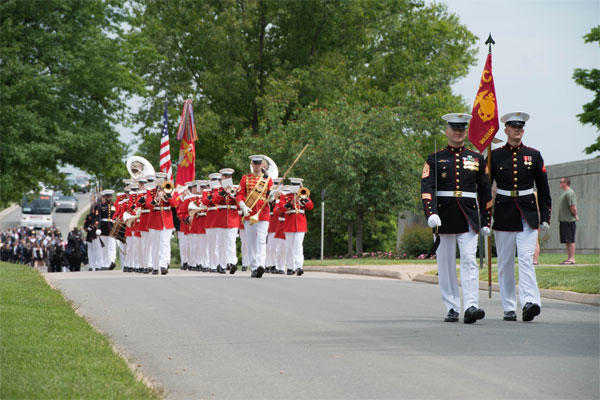ARLINGTON NATIONAL CEMETRY, Va. -- Under overcast skies, 10 Marines, two sailors and one airman were finally laid to rest in an internment ceremony for the troops who didn’t make it home in the aftermath of a CH-53 crash during The Battle of Koh Tang, May 15.
The 13 interred were in a waterborne CH-53 crash that occurred off the coast of Koh Tang, where half of the 26 occupants didn’t make it out of the water alive, lost to the Gulf of Thailand. The Joint POW/MIA Accounting Command recovered the dead from the battle and wreckage between 1991-2008. A wreath laying ceremony was held at the Tomb of the Unknown Soldier for three unrecovered Marines who were left behind in the chaos, May 12.
“There’s finally a little bit of closure to it,” said David Fowler, a former sergeant who was part of the assault. “People are accepting what happened and are understanding of our particular situation. It wasn’t the Tet Offensive, but when you’re in combat and it’s solid fighting all day, it’s a pretty heavy duty thing.”
The Battle of Koh Tang, otherwise known as the Mayaguez Incident, is considered by some to be the last battle of the Vietnam War. The mission came about when the SS Mayaguez, a U.S. merchant vessel, was captured by Cambodian Khmer Rouge forces, who claimed they crossed into Cambodian waters, May 12, 1975. The response was immediate, though in a tragic turn of events twenty-three airmen, preparing to support the coming rescue mission were killed in a helicopter crash in Thailand the same day. As a result, Marines were tasked with a full on assault.
For the operation, more than 200 Marines of Echo and Golf Companies, 2nd Battalion, 9th Marine Regiment, were to hit the island in a helicopter assault, flown by the Air Force.
Three days later, the 14-hour joint mission was underway to rescue the crew. The landing was overcome by intense enemy fire, where the communist troops directed machine gun, rocket, and indirect fire at the aircraft and disembarking Marines.
“I took a hit through the arm at that point, when he just touched the tail end of the bird down,” said Fowler. “I think everybody had gone into shock at that point, and were nervous as to what was going on because there was a lot of gunshots coming through the side of the helicopter.”
After that, Fowler was providing covering fire on the beach when he was hit by a close impacting mortar round, ridding his right arm with shrapnel.
Once it began, the mission quickly became a disaster. After the Marine elements landed, they were scattered in three positions across the island, fighting throughout the day to reconsolidate. While this occurred the Mayaguez crew was released by the Khmer Rouge on a previously captured fishing boat to return to their ship, which was recaptured by Delta Company, 1st Battalion, 4th Marine Regiment.
Once the Mayaguez and crew were back in U.S. hands, the operation turned quickly to withdrawing the Marines from Koh Tang. As fighting continued and the Marines came together, extraction became a harrowing affair.
“The extraction started and all hell broke loose,” said Stephen Poore, who was a corpsman at the time. “The first helicopter came in and the amount of gunfire in both directions was just unbelievable.”
As the troops were extracted, the perimeter they held would shrink, leaving the men on the ground in a difficult situation.
“During that time the enemy would move closer and closer to our positions and get better angles,” Poore said.
When the mission was coming to an end, and most troops were heading to the USS Coral Sea or already aboard, three Marines were left behind in the darkness and confusion of the hectic extraction. Lance Cpl, Joseph N. Hargrove, Pfc. Gary L. Hall, and Pvt. Danny G. Marshall, members of an M60 machine gun team, didn’t make it to the last departing helicopter.
Overall, 15 Marines, two sailors and one airman died, and 50 were wounded in the battle. The ship’s crew was eventually released unharmed on another previously captured fishing vessel as the battle was underway, but the invisible wounds still remain for the Marines who fought that fateful day.




























